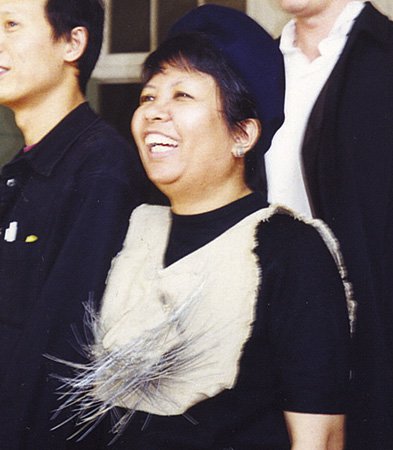Cultural Center of the Philippines
ENCYCLOPEDIA OF
PHILIPPINE ART
Scapular Gallery Nomad
1997-2002 / Performance / Artist: Judy Freya Sibayan
Scapular Gallery Nomad is a work by Judy Freya Sibayan “performed everywhere and at anytime” from 1997 to 2002. Sibayan’s performance and concept-based works, such as MoMO (Museum of Mental Objects), are posed as institutional critique. Conflating multiple roles assumed by various individuals working in an art institution, her performance involves wearing an enlarged scapular consisting of hand-sewn pouches. It is filled with hand-sized works of artists who are invited to exhibit in this literal pocket space within a particular duration. Envisioned as a “performance art gallery,” Sibayan fulfills various curatorial duties, among them preparation of exhibition notes, exhibition design, documentation and archiving, publicity, and audience development. As the owner and artist of the Scapular Gallery, her performance renders her agency visible. She is engaged in the production of the work as exemplified by the trace offered by the scapular and the use of her body as vehicle for site-specific works. In the process, she exposes the limits of her body and her autonomy as a singular entity emulating the work of an art institution. Sibayan describes the gesture as a “movement away from the center and into the periphery of production, circulation, and reception of art” (Sibayan 2014).
The impetus of Scapular Gallery Nomad is a personal and political one, borne from Sibayan’s reflection upon her artistic practice on the one hand, and the initial trajectory of her career as a cultural administrator, on the other. She relates how her works had been “legitimized” by the Cultural Center of the Philippines (CCP) via a group show in 1974 and a solo exhibition in 1975. She was later involved with CCP as a curatorial assistant to Ray Albano from 1976 to 1977, and as an artist who explored the CCP as a site of performance. After returning from her studies in the United States, she was appointed as director of the CCP Coordinating Center for Visual Arts, 1987-89. Tasked with the project of reconfiguring a center that had emerged from a dictatorial regime, Sibayan saw the conflicting discourse between museums and the self-criticality of contemporary art.
Sibayan’s referencing of the scapular as a miraculous object that protects the bearer from eternal doom is a poetic and cogent articulation of resistance to institutional systems. After resigning from her post in the CCP and withdrawing from the art world for several years, Scapular Gallery Nomad marked her return to a space that would enable her “devotion” to art. The scapular also functions as an amulet, affording the artist a level of autonomy and protecting her from having to perform roles constricted within historical or institutional parameters. Scapular Gallery Nomad was performed in the following museums from 1997 to 1999: the Vienna Secession, Austria; CAPC Musée d’Art Contemporain de Bordeaux, France; PS1 Contemporary Art Center, New York; and the Hayward Gallery, London; and from 2000 to 2001, at the Earl Lu Gallery, Singapore; and the Museum of Far East Antiquities, Stockholm, Sweden.
Written by Louise Anne D. Marcelino
Sources
Sibayan, Judy Freya. 2007. “Curating upon My Body.” Pananaw Philippine Journal of Visual Arts, edited by Patrick D. Flores, 6:24-29.
———. 2014a. Curriculum vitae. Nov.
———. 2014c. “Scapular Gallery Nomad: Beyond the Limits of the Center and Into One’s Own.” Art Service Association (ASA) Magazine, no. 4. Accessed Nov. http://www.asa.de/magazine/ iss4/17sibayan.htm.
